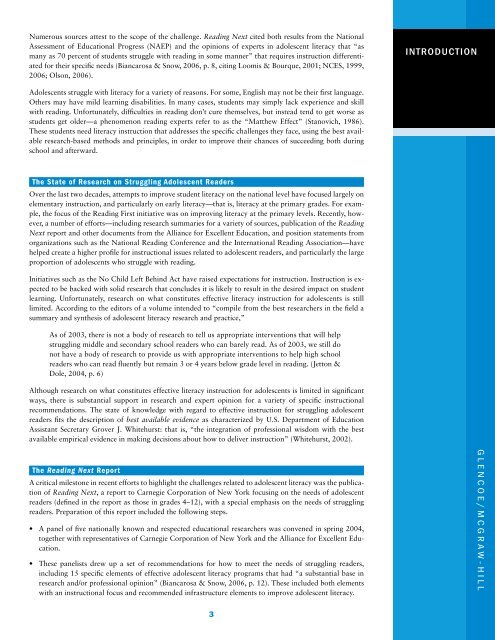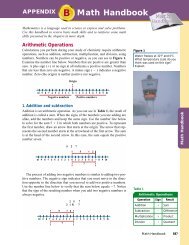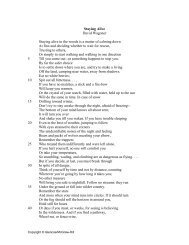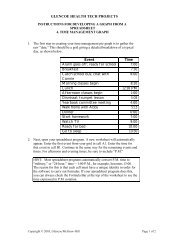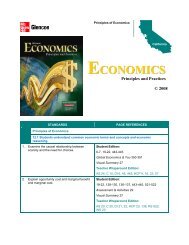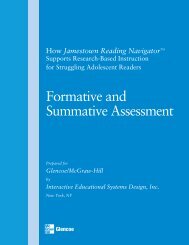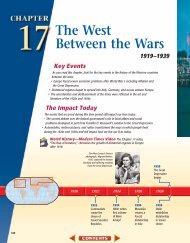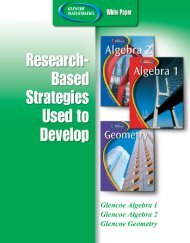Comprehension - Research
Comprehension - Research
Comprehension - Research
You also want an ePaper? Increase the reach of your titles
YUMPU automatically turns print PDFs into web optimized ePapers that Google loves.
Numerous sources attest to the scope of the challenge. Reading Next cited both results from the National<br />
Assessment of Educational Progress (NAEP) and the opinions of experts in adolescent literacy that “as<br />
many as 70 percent of students struggle with reading in some manner” that requires instruction differentiated<br />
for their specific needs (Biancarosa & Snow, 2006, p. 8, citing Loomis & Bourque, 2001; NCES, 1999,<br />
2006; Olson, 2006).<br />
Introduction<br />
Adolescents struggle with literacy for a variety of reasons. For some, English may not be their first language.<br />
Others may have mild learning disabilities. In many cases, students may simply lack experience and skill<br />
with reading. Unfortunately, difficulties in reading don’t cure themselves, but instead tend to get worse as<br />
students get older—a phenomenon reading experts refer to as the “Matthew Effect” (Stanovich, 1986).<br />
These students need literacy instruction that addresses the specific challenges they face, using the best available<br />
research-based methods and principles, in order to improve their chances of succeeding both during<br />
school and afterward.<br />
The State of <strong>Research</strong> on Struggling Adolescent Readers<br />
Over the last two decades, attempts to improve student literacy on the national level have focused largely on<br />
elementary instruction, and particularly on early literacy—that is, literacy at the primary grades. For example,<br />
the focus of the Reading First initiative was on improving literacy at the primary levels. Recently, however,<br />
a number of efforts—including research summaries for a variety of sources, publication of the Reading<br />
Next report and other documents from the Alliance for Excellent Education, and position statements from<br />
organizations such as the National Reading Conference and the International Reading Association—have<br />
helped create a higher profile for instructional issues related to adolescent readers, and particularly the large<br />
proportion of adolescents who struggle with reading.<br />
Initiatives such as the No Child Left Behind Act have raised expectations for instruction. Instruction is expected<br />
to be backed with solid research that concludes it is likely to result in the desired impact on student<br />
learning. Unfortunately, research on what constitutes effective literacy instruction for adolescents is still<br />
limited. According to the editors of a volume intended to “compile from the best researchers in the field a<br />
summary and synthesis of adolescent literacy research and practice,”<br />
As of 2003, there is not a body of research to tell us appropriate interventions that will help<br />
struggling middle and secondary school readers who can barely read. As of 2003, we still do<br />
not have a body of research to provide us with appropriate interventions to help high school<br />
readers who can read fluently but remain 3 or 4 years below grade level in reading. (Jetton &<br />
Dole, 2004, p. 6)<br />
Although research on what constitutes effective literacy instruction for adolescents is limited in significant<br />
ways, there is substantial support in research and expert opinion for a variety of specific instructional<br />
recommendations. The state of knowledge with regard to effective instruction for struggling adolescent<br />
readers fits the description of best available evidence as characterized by U.S. Department of Education<br />
Assistant Secretary Grover J. Whitehurst: that is, “the integration of professional wisdom with the best<br />
available empirical evidence in making decisions about how to deliver instruction” (Whitehurst, 2002).<br />
The Reading Next Report<br />
A critical milestone in recent efforts to highlight the challenges related to adolescent literacy was the publication<br />
of Reading Next, a report to Carnegie Corporation of New York focusing on the needs of adolescent<br />
readers (defined in the report as those in grades 4–12), with a special emphasis on the needs of struggling<br />
readers. Preparation of this report included the following steps.<br />
• A panel of five nationally known and respected educational researchers was convened in spring 2004,<br />
together with representatives of Carnegie Corporation of New York and the Alliance for Excellent Education.<br />
• These panelists drew up a set of recommendations for how to meet the needs of struggling readers,<br />
including 15 specific elements of effective adolescent literacy programs that had “a substantial base in<br />
research and/or professional opinion” (Biancarosa & Snow, 2006, p. 12). These included both elements<br />
with an instructional focus and recommended infrastructure elements to improve adolescent literacy.<br />
G l e n c o e / M c G r a w - H i l l


